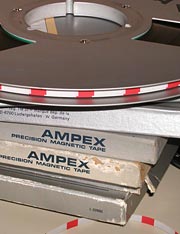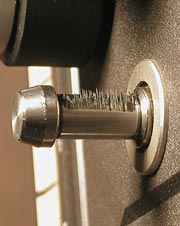Between the late 1970s and the early 1980s most audio tape manufacturers received bad batches of polyurethane binder that contained some molecules that were not as “poly” as the others. Shorter urethane molecules are hygroscopic. Consequently, tapes from this period may absorb moisture from the air, and over time, become sticky.
Bad tape is impossible to detect until it is too late, and the first sign of a problem appears when a valuable recording is brought out of storage and will not play properly. Many valuable master tapes have become damaged in this way. Some have been rescued, and some have been irretrievably lost.
Symptoms
- “Squealing” or “Squeaking”—the tape vibrates at a high pitch when playing (like blowing a blade of grass between your thumbs). This will frequency modulate the playback signal as the tape is vibrating on the heads at this pitch.
- Buildup of sticky black deposits on the heads and tape path.
- The tape machine does not wind in Fast Forward or Rewind.
What to Do
- Do not attempt to play the tape any more AT ALL!
- Wind the tape back neatly. If the machine will not spool, remove the head assembly (if possible) and rewind, giving the reels hand assistance.
- Clean the entire tape path very thoroughly. The tape exudes a black tar-like goo that sticks everywhere and is difficult to remove. Only use pure alcohol as for normal tape machine cleaning and do not scratch the deposits off.
- Arrange to send the tape to us for slow drying (aka “baking”).



